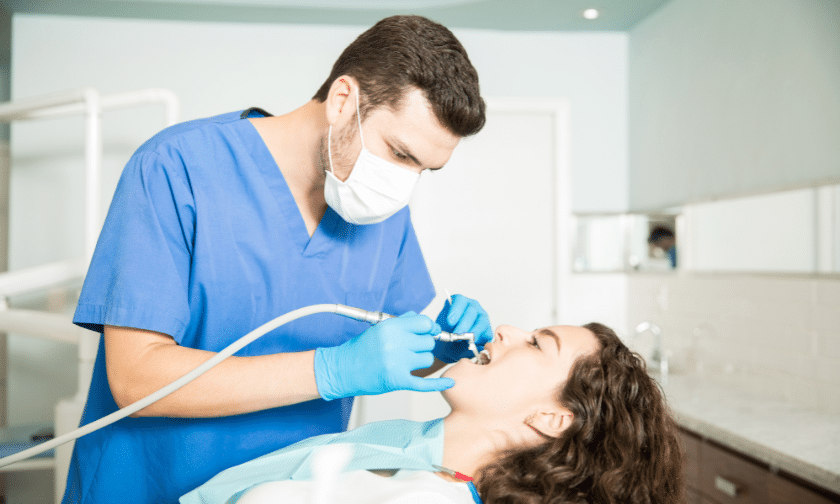


Invisalign vs Braces: A Guide to Choosing the Right Treatment for Your Teen’s Orthodontic Needs
There are a lot of different orthodontic treatments out there, and it can be tough to know which one is right for your teen. Invisalign and braces are two of the most popular options, and each has its own pros and cons. Here’s a quick guide to help you decide which treatment is right for your teen’s orthodontic needs.Invisalign is a clear plastic aligner that is virtually invisible when worn. It is removable for eating, drinking, brushing, and flossing, so it’s a convenient option for teens who want to avoid the hassle of traditional braces. However, Invisalign isn’t suitable for every case, and it can be more expensive than braces.
Braces are the more traditional orthodontic treatment, and they’re made of metal brackets that are attached to the teeth. They’re not as convenient as Invisalign because they can’t be removed, but they’re often more effective at correcting severe dental issues. Braces can also be less expensive than Invisalign in some cases.
Ultimately, the best way to decide which treatment is right for your teen is to consult with an orthodontist. They will be able to assess your teen’s individual needs and recommend the best course of treatment.
What is Invisalign?
Invisalign is an orthodontic treatment that uses clear, plastic aligners to gradually straighten teeth. Unlike braces, Invisalign aligners are virtually invisible and can be removed for eating, brushing, and flossing. Invisalign is a popular choice for teens because it is less noticeable than braces and does not require any dietary restrictions.
The Invisalign treatment process begins with a consultation with an orthodontist or dentist. During the consultation, the doctor will take X-rays, photos, and impressions of the teeth in order to create a custom treatment plan. Once the treatment plan is created, the patient will be given a series of aligners to wear over a period of time (usually around 12 months). Each aligner is worn for about two weeks before being replaced with the next in the series. As the patient wears each aligner, their teeth will gradually shift into place.
At the end of treatment, the patient will need to wear a retainer in order to keep their teeth from shifting back to their original position. Invisalign aligners are made from BPA-free plastic and are FDA-approved.
Benefits of Invisalign Over Traditional Braces
There are many benefits of Invisalign over traditional braces. First, Invisalign is nearly invisible, so your teen will not have to worry about feeling self-conscious about their appearance during treatment. Second, Invisalign aligners are removable, so your teen can continue to eat their favorite foods and brush and floss their teeth normally. Third, Invisalign treatment is typically shorter than traditional braces treatment, so your teen can get back to their lives sooner. Lastly, Invisalign aligners are more comfortable than braces, so your teen will be less likely to experience discomfort during treatment.
Source: Teeth Talk Girl
How To Choose The Right Treatment For Your Teen?
There are a few things to consider when choosing the right treatment for your teen’s orthodontic needs. First, you need to decide if you want traditional braces or Invisalign. Both options have their pros and cons, so it’s important to weigh your options before making a decision.<.
Traditional braces are more visible, but they’re also generally more affordable than Invisalign. They’re also typically faster at correcting dental issues than Invisalign. However, traditional braces can be uncomfortable and can require more maintenance than Invisalign.
Invisalign is less visible than traditional braces, but they’re usually more expensive. They also typically take longer to correct dental issues. However, Invisalign is more comfortable and requires less maintenance than traditional braces.
Once you’ve decided which type of treatment you want for your teen, you need to find an orthodontist that offers that treatment. Not all orthodontists offer both traditional braces and Invisalign, so be sure to ask before making an appointment.</
Conclusion
Ultimately, Invisalign and braces both provide effective orthodontic treatments for teens. The decision of which to choose will ultimately depend on your teen’s individual needs, the severity of their misalignment, and the most comfortable treatment option available. If you are still unsure about what is best for your teen’s orthodontic needs, it is important to consult with a professional dentist or orthodontist who can help you make an informed decision.
FAQs
1. What are Invisalign and braces?Invisalign is a clear aligner system that is used to straighten teeth without the use of traditional metal braces. Braces are metal brackets that are glued to the front of your teeth and connected by wires.
3. How much do Invisalign and braces cost? Again, there is no simple answer to this question as the cost will vary depending on each individual case. However, in general, Invisalign tends to be more expensive than braces.

Adult Orthodontic Treatments: An Overview
If you’re considering orthodontic treatment as an adult, you’re not alone. In fact, according to the American Association of Orthodontists, 1 in 5 orthodontic patients is over the age of 18. There are a variety of reasons why adults may choose to seek orthodontic treatment, including wanting to improve their appearance or correcting problems that have developed over time. Whatever your reason for considering orthodontics, it’s important to learn about the different types of treatments available so that you can make an informed decision. This overview will provide you with some basic information about adult orthodontic treatments.An overview of adult orthodontic treatments
Adult orthodontic treatments have become increasingly popular in recent years, due to advancements in technology and materials. Common services include metal, ceramic or clear braces as well as Invisalign and Damon systems. Traditional braces are the most common type of treatment selected, with metal brackets that are glued onto the front of your teeth. Ceramic brackets are becoming more popular as they provide a less visible option than metal brackets, yet may take longer to achieve desired results. Invisalign is an increasingly popular choice for adults since it uses clear aligners that can be removed while eating and brushing your teeth. Finally, Damon System braces use self-ligating slides instead of elastics to secure the wires, providing fewer adjustments and a shorter timeframe than traditional braces. When choosing an adult orthodontic treatment, it’s important to speak with a qualified practitioner so you can decide on the best option for your needs.The benefits of adult orthodontic treatments
Adult orthodontic treatments offer a wide array of benefits, making them an effective and advantageous choice for anyone looking to improve the aesthetic of their teeth. By realigning crooked or overcrowded teeth, adult orthodontic treatments improve the overall appearance of one’s smile. The physical effects are far-reaching, as correcting the alignment can lead to improved functionality and overall health. Since unhealthy patterns in the form of jutting jawbones or misaligned teeth can actually cause additional dental issues down the road, attending an adult orthodontic treatment is almost always a wise investment. Additionally, straightening your teeth will not only help you feel more confident about your smile but also limit wear and tear on your enamel due to improper jaw placement—allowing you to retain a natural, healthy smile well into adulthood.The types of braces available for adults
With more adults opting for orthodontic treatment, there are more types of braces for adults than ever before. Metal braces are still popular for both adults and children and offer durability and affordability that many favor. Clear ceramic braces have become increasingly popular among adults because they provide the same result as metal braces, but with a much more aesthetically pleasing look. Lingual braces are placed on the backs of your teeth instead of the front and work in the same way as traditional metal or clear braces. Finally, Invisalign has become the go-to choice for those who want a discreet option; these clear trays are nearly invisible and can fit more seamlessly into an adult lifestyle compared to other types of traditional braces. No matter what type of brace you choose, it is important to consult with an orthodontist prior to undergoing any treatment so you can find the best solution option for your individual needs.How to choose the right type of braces for you
If you’re considering braces to straighten your teeth and give you a beautiful smile, there are several types of braces to choose from. Depending on your lifestyle, treatment timeline, and desired outcome, one type of braces may be better for you than another. Traditional metal braces provide lots of strength for more involved dental issues and can be the most economical option. Ceramic or tooth-colored braces use clear brackets that blend in with your teeth and are less visible when you smile. Lingual braces are positioned against the back side of the teeth, making them invisible to the casual observer. For those who want to feel their teeth moving as soon as possible, Damon Clear Braces use a self-ligating system so archwires don’t require tightening—resulting in shorter, quicker treatments. Ultimately, the choice is yours: all types of braces will help give you the perfect smile eventually; it just depends on what type makes sense for you.The cost of adult orthodontic treatments
For adults who are considering orthodontic treatment, it’s important to understand the cost associated with the process. Generally speaking, adult braces cost anywhere from $3,000 to $8,000 or more depending on the complexity of your treatment plan and which type of braces you select. Insurance typically covers a portion of the cost if your policy includes orthodontic coverage, and some dental offices offer financing options that can ease costs over time. It’s a good idea to speak to both your insurance company and several orthodontists before committing to any treatments. By doing your research, you can make sure you reach a decision that works well for both your smile and your budget.The risks and side effects associated with adult orthodontic treatments
Adult orthodontic treatments can be beneficial when it comes to achieving straighter teeth, improving overall oral function, and treating certain malocclusions; however, there are a few risks and side effects associated with these procedures that patients should consider. In severe cases, orthodontic treatment could cause increased tooth sensitivity due to the adjustments being made to the enamel on the teeth. For this reason, it is important that patients attend routine checkups with their dentist to ensure their gums remain healthy throughout their course of treatment. Additionally, improper wear of retainers could result in the misplacement of teeth which can lead to more expensive treatments down the line. Taken together, adult orthodontic treatments can be a great solution for those who want straighter teeth; however, potential risks and side effects should also be considered before deciding to undergo the procedure. With all of this in mind, you should be able to make a decision about whether or not adult orthodontic treatment is right for you. If you do decide to go ahead with treatment, work closely with your orthodontist to choose the best type of braces for your smile and your lifestyle. Remember that there are risks and side effects associated with any medical procedure, but these can usually be managed effectively with the help of a qualified professional. Ultimately, the goal of adult orthodontic treatment is to improve your quality of life by giving you the straight, beautiful smile you’ve always wanted.
